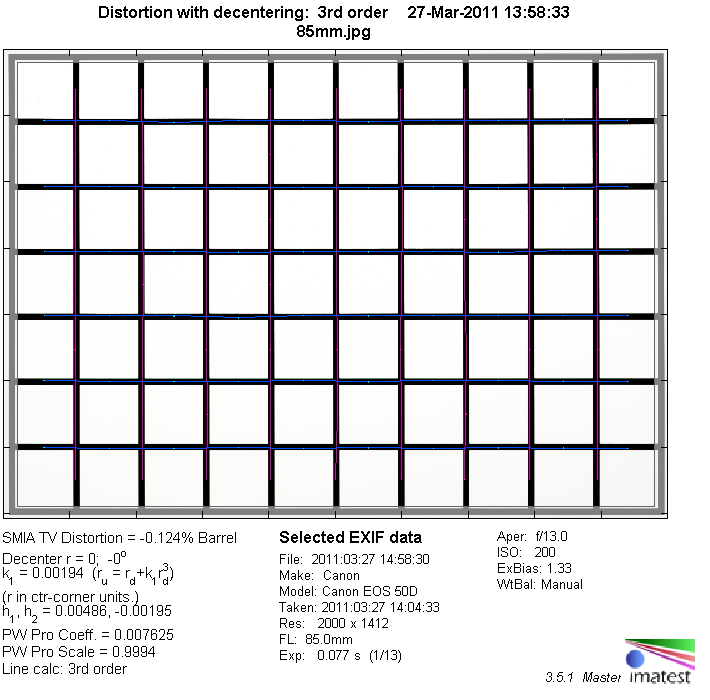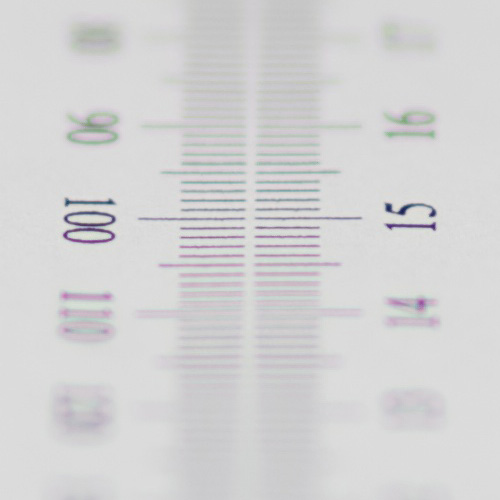|
Sigma AF 85mm f/1.4 EX HSM DG (EOS) - APS-C format Review / Lab Test - Analysis |
|
Lens Reviews -
Canon EOS (APS-C)
|
|
Page 2 of 2

Distortion
The Sigma produces an absolutely negligible degree of barrel distortion on APS-C format cameras.

Vignetting
The Sigma lens enjoys a sweet spot advantage when used on APS-C DSLRs so the light falloff isn't quite as pronounced as within its native format. At f/1.4 there's still some vignetting which may be visible in critical situations. Stopping down to f/2 resolves this issue from a field perspective.

MTF (resolution)
Full format prime lenses tend to have an easy job on APS-C DSLR in terms of resolution. However, the Sigma struggles somewhat at least at max. aperture. The center quality, and that's certainly where it counts most in this lens class, is already excellent. The border quality is just fair here though and the corners are downright soft. Stopping down to f/2 boosts the borders to good levels and also the corners recover quite a bit as well. The image quality is extremely high between f/2.8 and f/8. The peak performance is reached around f/5.6.
The field curvature is marginal and the overall centering quality of the tested sample was very good. In addition, the amount of focus shift when stopping down was very low.
Please note that the MTF results are not directly comparable across the different systems!
Below is a simplified summary of the formal findings. The chart shows line widths per picture height (LW/PH) which can be taken as a measure for sharpness.
If you want to know more about the MTF50 figures you may check out the corresponding Imatest Explanations
Chromatic Aberrations (CAs)
Lateral chromatic aberrations (color shadows at harsh contrast transitions) are generally very low with an average pixel width around 0.5px at the image borders.

Bokeh
The quality of the bokeh (out-of-focus blur) is a primary aspect for such a large aperture lens. The Sigma is capable of delivering very pleasing results here. Out-of-focus highlights have a very smooth inner zone and they remain circular till f/2.8. At f/4 you can spot some traces of the aperture shape. The "cat's eye" highlight shape in the image corner is largely avoided on APS-C DSLRs although there's a slight tendency towards an ellipsoid shape at max. aperture here. The foreground blur is buttery and the background is also very smooth albeit a tad more nervous.

Longitudinal (Axial) Chromatic Aberrations (LoCA)
LoCAs (non-coinciding focal planes of the various colors), sometimes called "bokeh CAs", are a general problem in this lens class. As you can notice below the halos have different colors - magenta (red + blue) in front the focus point and green beyond. The Sigma struggles somewhat more than usual here. The color fringing is very pronounced at f/1.4 and f/2. The effect remains visible at f/4 and there are also traces left at f/5.6.
These shots also show the almost complete lack of focus shift when stopping down, as mentioned in the MTF section.
|
Move the mouse cursor over the f-stop marks below to observe the respective LoCAs
|
| f/1.4 |
f/2 |
f/2.8 |
f/4 |
f/5.6 |
|

|
Sample Images
You can find some sample images taken with the Nikon D3x in our Nikon FX review of the lens.
VerdictThe Sigma AF 85mm f/1.4 EX HSM DG delivers a convincing performance on APS-C DSLRs although it stays somewhat short of the Canon EF 85mm f/1.2 USM L II here. The lens is impressively sharp in the image center - even at f/1.4 - but it's comparatively softer towards the borders/corners here. However, the Sigma is nothing short of excellent in the range between f/2.8 and f/8. Lateral CAs are minimal and not field-relevant. Same goes for image distortions. The vignetting is only a slight problem at f/1.4 and not an issue anymore from f/2 onwards. The quality of the bokeh is generally excellent except in very tricky situations. The amount of bokeh fringing (LoCAs) is on the high side,so you may spot some colored out-of-focus halos in critical situations.
The build quality of the lens is up to pro standards. The metal lens body is rubber-coated thus providing a good grip. The tightly assembled focus ring turns smoothly but it's a bit tricky to find the exact focus due to the very short focus path. On the other hand the same short focus is also responsible for fast auto-focusing so there's a certain trade-off here. We had no significant issues with focus accuracy on the tested sample. The Sigma AF 85mm f/1.4 EX DG HSM is quite expensive in absolute terms. However, even so it costs much less than the corresponding Canon lens (which is slightly faster though) and as such it is a highly interesting alternative.
| Optical Quality (Technical): |
 to to  |
|
|
| Field Quality: |  (Shallow Depth-of-Field Photography) (Shallow Depth-of-Field Photography) |
| Mechanical Quality: |  |
| Price/Performance: |  |
| | |
| | What does this mean ? |
|